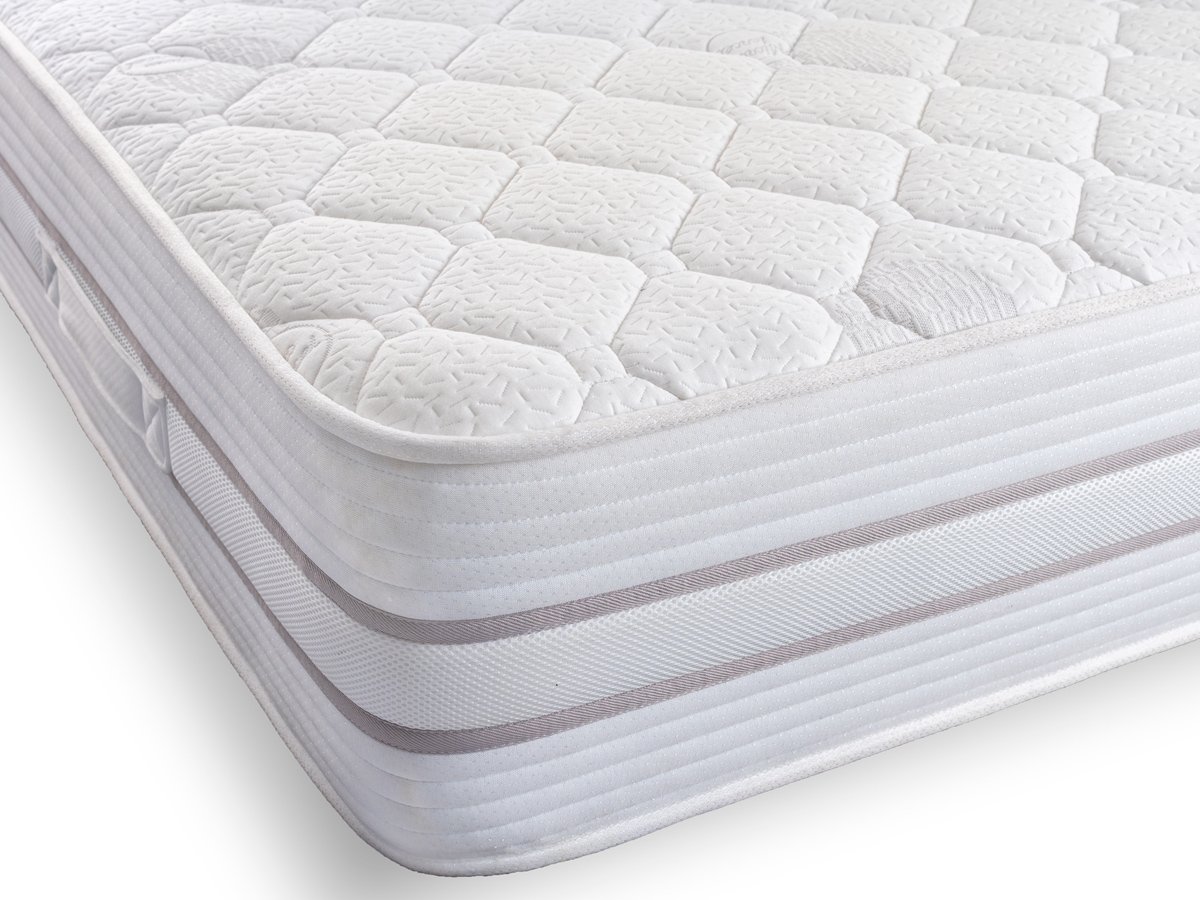Sleep Talk Blog, Sleep Issues, Health & Wellbeing
What's the Best Mattress for Back Pain?
Table of Contents
Finding the best mattress for back pain is crucial, as improper sleep support can significantly impact your spinal health. When mattresses lack adequate support, they can lead to poor sleeping posture and fail to maintain proper spinal alignment - a primary contributor to lower back pain. The best mattress for back pain helps alleviate these issues.
Similarly, mattresses that don't provide sufficient support can cause considerable sleep discomfort. Therefore, selecting the right mattress that suits your specific requirements is absolutely essential for maintaining good back health.
Today's market offers an extensive range of mattresses designed to address various sleep-related concerns. This comprehensive guide focuses specifically on individuals experiencing lower back complaints and aims to help them make informed decisions when selecting new mattresses for optimal comfort and support.
Best Mattress for back pain
The best mattress for back pain is often medium-firm, striking a balance between support and comfort.
It's important to note that there isn't a one-size-fits-all solution when it comes to finding the best mattress for back pain. The ideal mattress is one that enables an individual to sleep comfortably without experiencing pain or discomfort. To make an informed choice, it's beneficial to understand the key components that make up a quality mattress.
Understanding the best mattress for back pain is essential for anyone suffering from discomfort. The right choice can drastically improve sleep quality and overall health.
When searching for the best mattress for back pain, it's wise to consider your sleeping position and preferences, as these factors will influence your comfort levels.
The spring system serves as the foundation for back support, with different mattresses featuring varying coil configurations. The number and arrangement of these coils can significantly impact the mattress's supportive properties. Higher-quality spring systems often provide better weight distribution and targeted support for pressure points.
The padding layers above the springs come in various thicknesses and materials, each offering different levels of comfort. Modern mattresses range in depth from 6 to 28 inches, with premium options often featuring multiple comfort layers designed to work in harmony with the spring system.
Choosing the best mattress for back pain can involve trying different types to find the one that suits your needs best.
The best mattress for back pain may vary for each individual, making personal testing crucial.
When selecting a mattress, customers should carefully consider the combination of coils, padding thickness, and overall depth that best suits their needs for optimal support and sleep comfort. These elements work together to create the perfect balance for your sleeping requirements.
Investing in the best mattress for back pain can lead to long-term health benefits and improved sleep quality.

Consider the best mattress for back pain that comes with a trial period, allowing you to ensure it meets your comfort standards.
The Sirocco 2000 mattress is designed to deliver the ultimate combination of comfort, support, and temperature regulation. At its core, a sophisticated pocket spring system incorporates 2000 individually nested springs that respond independently to your body. This advanced design ensures total comfort and zoned support, promoting healthy spinal alignment and reducing motion transfer between partners.
Quality mattresses designed for back pain should provide robust support while accommodating the spine's natural curvature. Recent research has revealed an interesting finding: medium-firm mattresses tend to offer superior back pain relief compared to their firmer counterparts. This discovery challenges the traditional belief that firmer mattresses are always better for back pain.
Finding the right balance between sleep comfort and back support is absolutely crucial for managing back pain effectively.
When shopping for a new mattress, it's essential to prioritise quality over price. Making an investment in a high-quality mattress is particularly worthwhile if you're seeking to alleviate lower back pain. The best mattress for back pain often comes with a higher price tag, but the benefits to your health and well-being make it a worthwhile investment.
Premium mattresses typically feature superior spring systems, enhanced quality fillings, and additional comfort layers, making it easier to achieve the perfect balance between comfort and support. These higher-end options often provide better pressure relief and spinal alignment.
Proper maintenance of your new mattress is essential for longevity and consistent support. It's recommended to reposition your mattress every six months to ensure even wear. This maintenance routine should include both rotating the mattress 180 degrees and flipping it lengthwise at regular intervals.
For individuals over 50 seeking guidance on purchasing single or double beds, we've compiled comprehensive advice below to assist in making informed decisions when shopping for beds online.
Consider combination beds that feature firm core support to maintain proper spinal alignment, complemented by plush top layers for a comfortable sleeping surface. Avoid automatically opting for orthopaedic single or double beds, as these may prove too firm for your needs. While older individuals may experience more frequent back problems, they often also have more sensitive joints requiring additional cushioning.
When selecting single and double beds, consider models with greater depth, as these provide easier access for getting in and out of bed. This feature is particularly beneficial for individuals with mobility concerns or back issues.
Firmer beds generally offer better support, especially for those who spend time sitting in bed. Additionally, a robust base – whether solid top, firm edge, or one of the superior spring edge base beds – will provide better stability for anyone who regularly sits or leans on the bed's edge. This added stability can help prevent further strain on the back and promote better posture while seated.
A soft sleeping surface contributes significantly to bed warmth by providing superior insulation properties. Even when opting for firm single or double beds, you can enhance comfort with luxuriously quilted pillow tops that add an extra layer of cosiness without compromising support.
Modern bed technology has revolutionised sleep comfort with the introduction of adjustable features - single and double beds now come with customisable neck, foot, head, and leg rests. These adaptable features are particularly beneficial for individuals who require extended bed rest, suffer from high blood pressure, or manage rheumatic conditions.
When it comes to finding the best mattress for back pain, especially for couples, more spacious single or double beds offer distinct advantages. The increased sleeping area significantly reduces partner disturbance - a crucial consideration for older individuals who typically experience lighter sleep patterns.
For double beds, it's advisable to choose a minimum width of 150cm (5ft) to ensure adequate space. Single beds should measure at least 90cm (3ft), though opting for the more generous 105cm (3ft 6ins) dimension provides enhanced comfort and movement freedom.
Zip and Link Beds
The innovative concept of zip and link beds - comprising two separate mattresses and bases - offers remarkable versatility. This design allows partners to customise their individual support and comfort preferences while maintaining the appearance of a unified bed.

Should one partner fall ill, these beds can be easily separated into two singles, facilitating better care and mobility. The split design also simplifies bed making and mattress rotation, making maintenance more manageable for those with limited strength or mobility.
Back pain affects an overwhelming majority of people, with statistics showing that 8 out of 10 individuals experience it at some point in their lives. If you're among those struggling with back discomfort, you're likely eager to explore various solutions, and your mattress should be a primary consideration in your search for relief.
Many people don't realise that their mattress might not only be failing to alleviate their back pain but could actually be exacerbating it. If you find yourself reaching for pain medication first thing in the morning, it's time to evaluate your sleeping surface. Your mattress should serve as a supportive ally in your journey to better back health, not a hindrance to your comfort and well-being.
Historical wisdom suggested that the best mattress for back pain was invariably the firmest option available. However, contemporary research has challenged this one-size-fits-all approach. Current understanding acknowledges that mattress selection is highly individual, with limited conclusive research supporting any single type as universally superior for back pain relief.
Don't underestimate the importance of finding the best mattress for back pain; it can make a significant difference in your life.
A crucial factor in mattress selection is its ability to maintain proper spinal alignment during sleep. While we rest, our muscles and ligaments need to recover and rejuvenate. An overly soft mattress can create a hammock effect, causing your body to sink too deeply and providing inadequate support for proper spinal alignment.
For those uncertain about their ideal firmness level, a medium-firm mattress often serves as an excellent starting point. If you enjoy a more responsive sleep surface, pocket sprung mattresses offer an excellent solution, with their individually wrapped coils providing targeted pressure relief and support where needed most.
Memory foam mattresses have gained significant popularity among back pain sufferers. These innovative sleep surfaces excel at conforming to your body's unique contours, delivering exceptional comfort while simultaneously providing crucial pressure relief in sensitive areas, particularly beneficial for those experiencing back discomfort.

When selecting your ideal mattress, consider your sleep position and other personal factors such as body weight, as these significantly influence your mattress needs. These considerations play a vital role in determining the most suitable mattress type for your specific situation.
For instance, individuals with higher body weight and those who prefer sleeping on their front or stomach often find that spring mattresses provide optimal support for their needs. Conversely, side sleepers frequently discover that memory foam mattresses offer the perfect balance, conforming to their body's natural curves while maintaining essential spinal support.
The most crucial aspect to remember during your mattress selection journey is that it's an intensely personal decision. To make the most informed choice possible, take time to understand and investigate the physical components of different mattress types. This knowledge will help you select a mattress that promotes restful, pain-free sleep and supports your overall well-being. Remember, investing time in choosing the right mattress can significantly impact your quality of life and daily comfort levels.

